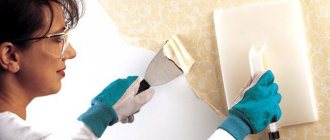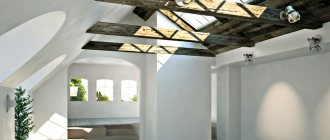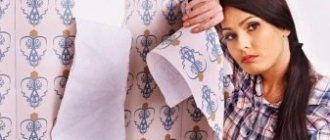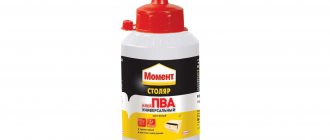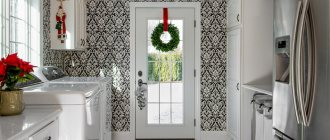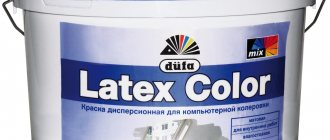If you decide to use original material when decorating the room, then covering the walls with flock wallpaper would be an excellent option. They can give the room an extraordinary feeling of lightness, as well as add warmth and comfort. Next, we will look in detail at what flock wallpaper for walls is, what their features are and how they are glued to walls.
Wallpaper flock with floral pattern
Story
The history of flock wallpaper comes from the archives of the V& A Museum in London.
The exact dates of the appearance of flock wallpaper are not known, but it is believed to be the 17th century. The mention of flock wallpaper is recorded in a trade card (something like our advertising leaflet) of Edward Butling from 1690:
At that time, fabrics and panels with lace patterns made from cut velvet were popular, but these were expensive fabrics. Paper wallpaper was used as a cheaper fabric substitute that was also more durable. Moths spoiled fabric decors, but did not touch the wallpaper, because they contained turpentine glue, which was used to glue the pile, which was not to the moth’s taste.
When making wallpaper, we used paper for the base and flock - fine pile, waste from wool production. The wallpaper production process consisted of three stages: printing the paper base; applying glue or glue mixed with paint; applying lint to glue. Printed using the block printing method.
Particularly popular at that time was the color combination of wallpaper with a crimson flock pattern applied to a pink base. This wallpaper design was used to decorate the Queen's drawing room at Hampton Court Palace, as well as the Privy Council chambers around the 1730s. Only a yellowed scrap of wallpaper has survived:
How to glue wallpaper
If you are thinking about how to glue flock wallpaper, then you should understand that this is a rather complex process that has its own nuances. You can do this work without the help of specialists, but you must follow all the rules.
Preparing the base
The first thing to do is level the wall. Yes, the canvases will be able to hide minor imperfections, and this makes it possible not to apply a finishing layer of putty. But you will still have to fix all large cracks, as well as depressions and bulges. It is necessary to make the wall as even as possible, this will avoid many problems.
Before starting pasting, it is important to prime the surface. It is best to use acrylic primer, which has the best characteristics.
Pasting of canvases
Only after preparing the surface can you begin gluing. At this time, it is necessary to cut the material so that the canvas matches the length of the walls, and also protrudes by 2-3 centimeters. They can be cut off later, but this will prevent mistakes.
It is imperative to draw a vertical line on the wall along which the first strip will be glued. It is better to use a special plumb line or level. The glue is applied exclusively to the wall, since the surface of the paintings is very delicate.
Next, you should apply the sheet to the wall and level it. It must be glued exactly along the first line. All the following canvases are applied exactly at the joint. Do not forget that it is important to avoid the formation of air bubbles. Yes, the surface of the wallpaper hides all unevenness quite well, but poorly done work will still be noticeable.
Drying should take at least a day. At this time, normal humidity should be maintained in the room, and drafts should not be allowed. After complete drying, the coating is completely ready.
How modern flock wallpaper is made
Modern flock wallpaper is made using both ancient technologies, to preserve naturalness, and by combining technologies. The manufacturing process when combining technologies is as follows. First, on a modern machine, the base is printed. Then, glue-ink is printed and applied on surface printing machines. Example on a photo collage:
The basis of the wallpaper is high-density non-woven fabric. A good-quality interlining is needed because the velvet pattern is heavy. In addition, when applying the pile, the wallpaper undergoes another test - it is shaken and tapped with special impact strips. This process is necessary so that the fibers, rubbing against each other, are magnetized and fixed vertically, like metal filings on a magnet, and form an even vertical edge:
As a result, a clear outline of the flock pattern is formed. The adhesive paint for the base of the pattern is selected in the same color as the flock to increase the depth of color. For the flock material itself, nylon and polyester are now used instead of wool.
The video shows part of the production process of flock wallpaper from the English company 1838 Wallcoverings:
Recommendations for use
For high-quality gluing, you should get a special glue for heavy wallpaper and make sure that excess adhesive, both when gluing the strip directly and when ironing it with a soft roller, does not get onto the decorative surface.
And if with flock on non-woven fabric there are no questions about where to apply the glue, then the technique of applying it to paper-based flock wallpaper, contrary to popular belief, is based on processing the plane itself, and not the paper web, which eliminates the possibility of deformation or tearing of the strip .
Even taking into account the excellent water resistance of acrylic fibers, the paper base of the wallpaper will not be able to withstand the onslaught of water. Therefore, it is advisable to use flock wallpaper in dry rooms, excluding kitchens, bathrooms and other wet rooms.
Flock wallpaper is a decorative finish of the highest quality. A luxurious texture that recreates the softness and silkiness of the fabric, as well as a variety of designs will help not only create an interior filled with notes of individuality, but also bring a harmonious mood to it.
Wallpaper prints and designs
Flock wallpaper designs are presented in the online store oboivdom.by by manufacturers: 1838 Wallcoverigs (England) and Origin (Netherlands)
1838 Wallcoverigs England. Avington and Camellia collections:
1 of 6
— +
Drawings in designs: damask, foliage silhouette.Origin Netherlands – Grandeur and Couture collections:
1 of 4
— +
Advantages and disadvantages
Any material has its pros and cons, which you should know about before purchasing.
Advantages
- High degree of thermal insulation. The efficiency of a canvas with a thickness of only 2 millimeters will be more effective than a polystyrene panel of 10 millimeters.
- High reliability.
- A pleasant coating that can imitate velor, suede and other soft materials. But their price will be much lower.
- Manufacturers offer a large number of colors and patterns.
- Easy to care for with a dry cloth.
- Environmentally friendly. These are one of the most natural finishing materials used for walls. They are used in bedrooms and children's rooms.
- When using flock wallpaper, you can hide unevenness and defects in the walls. This allows you to not be so careful in preparing surfaces
Flaws
Of course, the materials also have a number of disadvantages. They do not withstand moisture, and can only be used in the bedroom or living room. They will not be able to withstand the loads in the kitchen or bathroom.
The cost of such products is quite high. But the decorative properties are so good that many buyers do not pay attention to the price. They can be used in almost any design.
How to use and what to combine flock wallpaper in the interior
Flock has a contrasting texture, this must be taken into account for a balance and contrast combination (these principles of combinations were discussed in the previous article).
Balance combinations:
Textural balance - wallpaper creates a unified combination with materials: velor, velvet, plush. This could be furniture upholstery, curtains, decorative elements:
Style balance - wallpaper with a damask pattern will continue the style composition in styles: classic and its varieties, art deco, glamorous:
In the English interior style, flock wallpaper is a basic design element.
Contrasting combinations:
Textural contrast - the visual and sensory softness of velvet will contrast with hard surfaces: metal, stone, glass. Contrast will be more pronounced in combination with glossy surfaces:
Color contrast – the most contrasting combination will be the deep black color of the flock pattern with white in other design elements.
Contrast of styles - wallpaper with a classic pattern will create the opposite of industrial styles:
Advantages of flock coatings
What is the beauty of this newfangled coating?
- It's fashionable and modern. Flock coating is a new product in decoration. Using a modern type of decor, the designer will be able to implement the most original color and texture solutions and leave boring wallpaper and ordinary painting in the past. Can experiment with the shape of walls, ceilings and other building elements. Then the projects of individual residential buildings will not be monotonous and will be more willingly chosen by customers
- Versatility and variety. Versatility lies in the ability to cover any elements: a flat wall, intricate stucco molding or a figured column. It will be easier for builders to implement fantastic projects of VIP houses. In terms of variety, flock is probably in first place among finishing materials. Flocks can be large or small, round or shapeless, of the same shade or multi-colored, similar to fibers or pieces of stone. And the color range is not limited at all
- Durability, practicality. The flock coating is strong and durable. Easy to care for, easy to clean with detergent, does not fade. Easily hides minor surface imperfections
- Safety. It is a heat insulator and does not ignite easily. Environmental safe material
Flock coating has a drawback that is not decisive. To perform the work, you must have the experience of a specialist and the availability of a special pistol.
Flock wallpaper material for ideas and fantasies
Flock wallpaper is a material for inspiration, decor that does not make itself, it is complex, but that’s why it’s beautiful. Use it to create an accent, rhythm, and add visual and tactile sensations to the interior.
Flock wallpaper - an atmosphere of elegance, glamor, conservatism and... sexual mystery, like lace on women's mm... clothes:
And one more note for fans of the modern series Sherlock Holmes. The wallpaper design in Sherlock's room is made from flock wallpaper.
Unfortunately, there is no exact repetition in the online store, but you can replace it with others.
Where to see prices and buy
View other catalogs on the website of the online store oboivdom.by, here you can also order wallpaper samples by mail and buy the desired wallpaper with delivery. Delivery: to Belarus, Russia, Ukraine, Kazakhstan.
Look at the electronic wallpaper catalogs on the website 7x7.by, and physical catalogs and samples in the 7x7 showroom, which is located in Minsk at the address: Lozhinskaya street, building 4, on the first floor of a business building, with a separate entrance from the street.
Useful articles on the topic wallpaper
How to choose wallpaper. How to decide on wallpaper design. Read the article that breaks down the design point by point.
Subscribe to notifications of new publications by email or on social networks:
| Add to our groups on social networks: |
Properties and characteristics of flock wallpaper
Flock wallpaper is a three-layer material made by spraying textile flakes onto a base pre-treated with an adhesive. Previously, the role of flakes was played by wool or silk textile fibers, which significantly increased the cost of products.
Today, the place of textiles has been taken by cheaper, but no less attractive acrylic scales (chips).
In addition, the use of acrylic pile gave the coating a number of improved characteristics, while maintaining the original lightness of the wallpaper. The final third layer is most often a transparent varnish, the main purpose of which is to secure the flock scattering and give the canvas wear resistance and moisture resistance.
Depending on the type of base, flock wall coverings are divided into two groups:
- Paper-based canvases;
- Flock wallpaper on a non-woven base.
Both types are produced on the basis of cellulose fibers, however, for flock fabrics on non-woven fabric, cellulose fibers undergo additional treatment with chemicals.
The surface can be:
- plain;
- color;
- textured;
- smooth.
Regarding the question of which is better - a paper or non-woven base, it is worth saying that thinner paper still tends to be inferior in characteristics, but such wallpaper also costs an order of magnitude cheaper.
The advantage of paper-based flock wallpaper is that vapor permeability and adhesion are higher. Non-woven flock coverings are expensive, but also more practical, durable and tear-resistant.
Flock wallpaper, the price of which varies from 4,000 to 35,000 rubles. per roll (depending on the manufacturer), have a standard length of 10 m and a width of 0.5 to 0.8 m. They are produced by foreign manufacturers in Germany, Italy, the USA and England.
The definition of flock wall coverings often refers to dry flocks. Indeed, in the completed and hardened state, the appearance of the coating is identical to the surface obtained as a result of finishing the walls with flock wallpaper on non-woven fabric or paper.
However, in this case, dry flocks (mother-of-pearl, shimmering circles, straws, stars) are independently applied to an adhesive base, which makes the surface similar to liquid wallpaper, that is, decorative putty or plaster.

